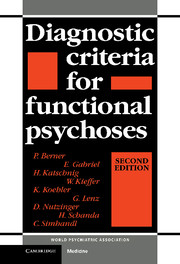A - Introduction
Published online by Cambridge University Press: 07 September 2010
Summary
The functional psychoses continue to be classed as illnesses of unknown origin. Diagnostic concepts for this category can be considered only as hypotheses, the validity of which depends on extrinsic criteria such as course and outcome, genetic data, response to treatment, and results of biological investigation. The requirement for validation is that the procedure for diagnostic attribution in question be set up in an unequivocal and reproducible manner. The operational diagnostic criteria, which have been developed primarily within the last fifteen years, issue from this concern.
Our intentions in presenting this collection of diagnostic criteria are twofold: first, to offer a comprehensive view of the present state of diagnostic formulations for functional psychoses; second, to encourage greater involvement in a ‘polydiagnostic approach’ (Berner and Katschnig, 1983) to psychiatric research, an endeavor consisting of the simultaneous application of as many diagnostic criteria as possible to the same patient population. After rendering a brief historical account of the principles which have governed diagnosis in our area of concern, this introductory chapter goes on to present the polydiagnostic approach.
Functional psychoses, principles of diagnosis
Kraepelin, building on the knowledge of his French and German predecessors and taking course and outcome of morbid states as the most important guidelines, presented the fundamentals of his psychiatric nosology in 1899. He conceived dementia praecox and manic-depressive illness as the main categories of disorders of unknown origin, but maintained paranoia – and in some elaborations of his classification also paraphrenia – as separate entities.
- Type
- Chapter
- Information
- Diagnostic Criteria for Functional Psychoses , pp. 1 - 10Publisher: Cambridge University PressPrint publication year: 1992

